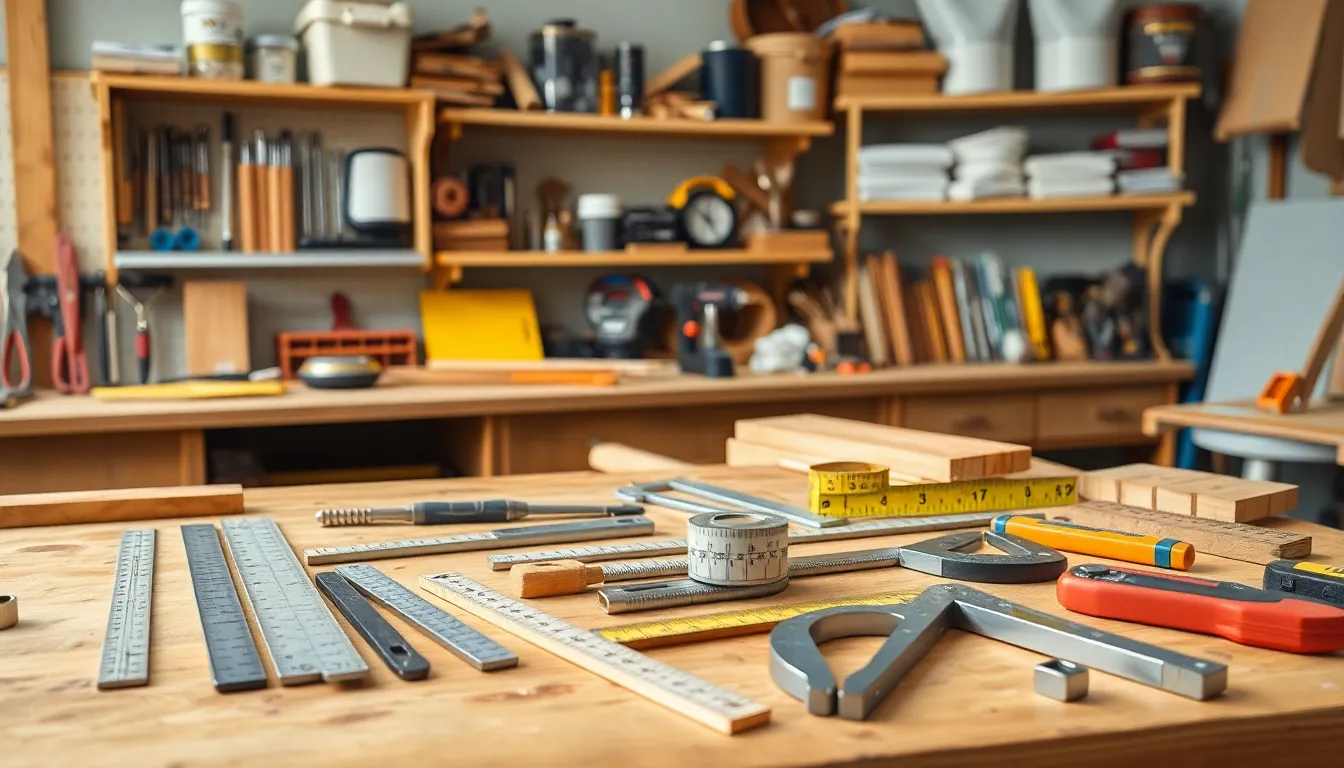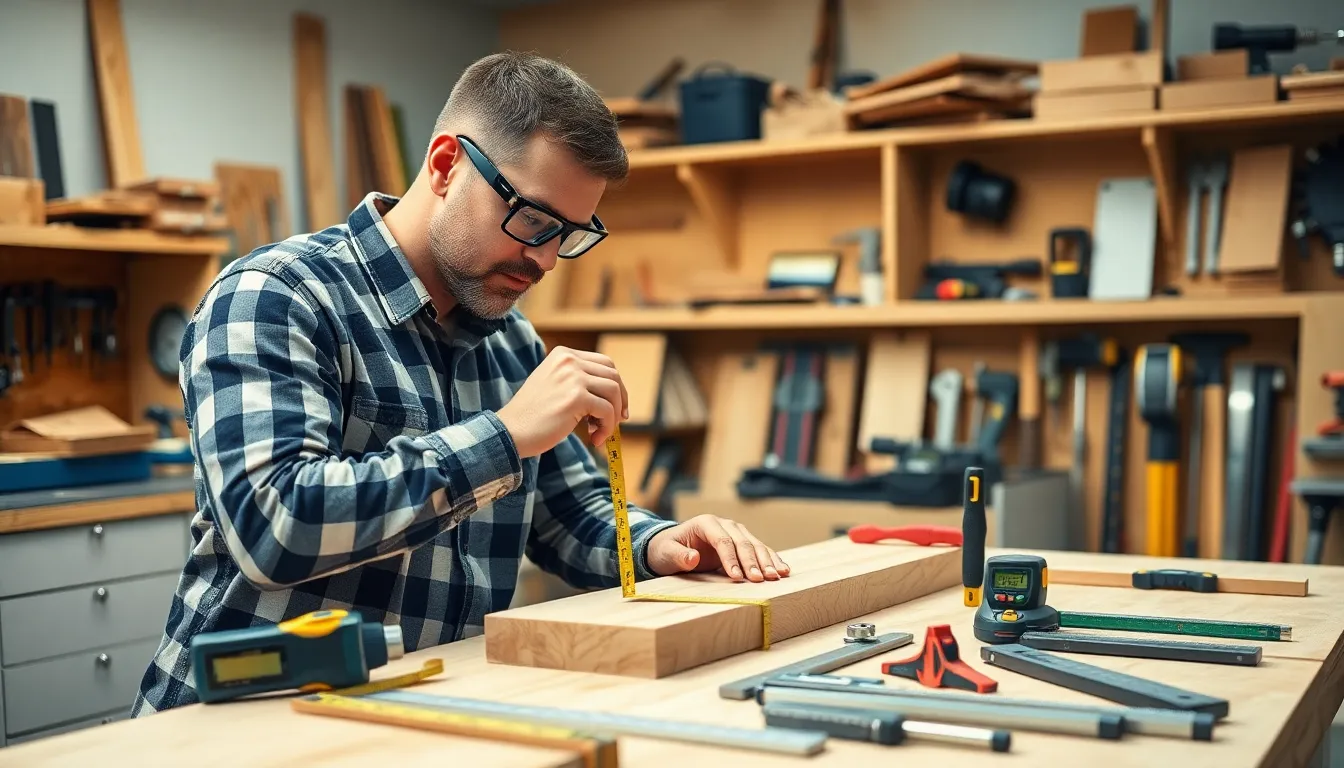Table of Contents
ToggleIn any workshop, measuring tools are the unsung heroes, quietly ensuring that projects don’t turn into abstract art. After all, nobody wants a table that wobbles more than a three-legged dog. Whether it’s a trusty tape measure or a digital caliper, these gadgets are essential for precision and accuracy.
Imagine trying to build a bookshelf without knowing if your wood is cut straight. It’s like baking a cake without measuring the flour—chaos ensues! With the right measuring tools, workshop warriors can tackle any project with confidence, turning their visions into reality. So let’s dive into the world of measuring tools and discover how they can save time, materials, and maybe even a few sanity points along the way.
Overview of Measuring Tools in Workshop
Measuring tools serve a critical function in workshops, as they ensure accuracy in every project. Various types include rulers, tape measures, calipers, and squares, each designed for specific applications. Rulers work well for straight measurements, while tape measures provide flexibility for larger objects.
Calipers measure internal and external dimensions, enhancing precision. Digital calipers offer easy readability, reducing human error. On the other hand, squares assist in achieving right angles, which is vital for frameworks.
Laser distance measurers represent a modern alternative, delivering fast readings over longer distances. These tools often include advanced features like memory storage to aid in recording multiple measurements.
Workshops also benefit from specialized measuring tools such as micrometers, which deliver precision for small dimensions. They play a key role in machining processes, where tolerances are vital.
Portable toolboxes often house a mix of rulers, levels, and measuring tapes, allowing for quick access during projects. Standardizing measurements can help maintain consistency across various types of work.
Attention to detail makes a significant difference in quality and outcomes. Using these measuring tools effectively can prevent costly mistakes and optimize resource usage.
Types of Measuring Tools

Measuring tools are essential for achieving precision and accuracy in various projects. Numerous types of measuring tools exist, each designed for specific applications.
Linear Measuring Tools
Linear measuring tools focus on straight measurements. Rulers serve as the simplest example, suitable for short distances and basic measurements. Tape measures excel at measuring longer distances, providing flexibility with their retractable design. Surveyors and builders frequently utilize measuring wheels, known for measuring large areas on the ground. Calipers enhance measurement precision, effectively gauging both internal and external dimensions. Digital calipers, with their easy-to-read displays, minimize human error significantly.
Angular Measuring Tools
Angular measuring tools assist in determining angles accurately. Protractors are commonly used for measuring angles in drafts and plans, offering a clear scale for quick readings. Bevel gauges help transfer angles from one surface to another, making them invaluable for intricate projects. The inclusion of digital protractors enhances measuring ease, providing immediate feedback. Squares ensure right angles are achieved during construction, which is crucial for creating stable frameworks. Each tool supports various tasks, contributing to overall project success.
Specialty Measuring Tools
Specialty measuring tools cater to unique requirements in specific fields. Micrometers provide high precision in measuring small objects, making them ideal for machining processes. Laser distance measurers offer speedy readings over long distances with advanced features like memory storage. Toolmakers benefit from height gauges, which measure vertical distances accurately. Clinometers are used for measuring slopes, particularly in landscaping and construction projects. Unique tools like these enhance accuracy and efficiency in specialized applications.
Choosing the Right Measuring Tool
Selecting the appropriate measuring tool enhances precision and efficiency in every workshop project.
Factors to Consider
Consider the project’s requirements first. Think about the specific measurements needed and the environment where the tool will be used. Identify the length, width, or height to determine the most suitable measuring tool. Evaluate accuracy as different tools provide varying levels of precision. Rulers excel in straightforward tasks while calipers are better for intricate measurements. Weight factors into the decision, too; lightweight tools facilitate portability. Assess your budget since high-quality tools might cost more but often yield better long-term results.
Popular Brands and Models
Many reputable brands dominate the measuring tool market. Stanley produces durable tape measures known for accuracy and reliability. DeWalt offers laser distance measurers with advanced features, ideal for professional use. Mitutoyo stands out for calipers and micrometers, emphasizing precision in engineering applications. Johnson Level manufactures quality squares and levels, catering to carpenters and builders. Consider finding models that suit personal preferences while balancing performance and cost. Brands like Bosch and Klein also provide innovative solutions, enhancing the user’s measuring experience.
Maintenance of Measuring Tools
Maintaining measuring tools ensures accuracy and longevity. Regular cleaning prevents dirt or debris buildup that can affect performance. Inspecting tools frequently identifies wear or damage early on, allowing for timely repairs or replacements.
Calipers and micrometers require particular attention due to their precision. Calibration should occur periodically to maintain accuracy, especially for digital versions. Tape measures benefit from careful storage to prevent bending or kinking.
Using protective cases or pouches helps preserve tools during transport, avoiding damage. Rulers and squares need protection from warping, which can affect measurements. Ensuring tools stay within their optimal environment also helps; high humidity or extreme temperatures can cause deterioration.
Users should document maintenance schedules to track when tools were last serviced. Organizing tools in portable toolboxes not only keeps them accessible but also ensures they remain in good condition. Regular maintenance checks as part of an overall workshop routine keep measuring tools functioning effectively.
Replacing worn-out tools immediately prevents inaccuracies from creeping into projects. Prioritizing tool care can lead to improved project quality. Employing these maintenance practices results in fewer costly mistakes, ultimately enhancing workflow efficiency and accuracy in measurements.
Safety Tips When Using Measuring Tools
Measuring tools enhance efficiency in workshops, but safety remains paramount. Always inspect tools before use for any signs of wear or damage. Ergonomics play a crucial role in reducing fatigue, so use tools suited for one’s grip and work style.
When working with measuring tapes, ensure the blade locks securely in place to prevent accidental retraction. A sudden snap can cause injury. Calipers require careful handling; always close the jaws gently when measuring to protect both the tool and fingers.
Additionally, maintain a clutter-free workspace to avoid accidents. Tools left unattended can create tripping hazards. Training on the proper use of tools also ensures users understand safe handling techniques. Familiarity with tools leads to improved confidence and enhanced safety.
Eye protection is vital, especially when using tools that involve cutting or projecting measurements, like laser distance measurers. Stray beams can cause serious eye damage. Furthermore, wear gloves when necessary to protect hands from sharp edges or rough surfaces.
Storing measuring tools in designated areas after use prevents damage and promotes organization. Consider using toolboxes with cushioning to safeguard delicate instruments like calipers. Organizing tools also speeds up workflow, reducing time spent searching for misplaced items.
Prioritizing safety while using measuring tools ensures optimal performance and prevents injuries. A secure and organized workshop environment benefits both efficiency and well-being.
Measuring tools are indispensable in any workshop. They not only enhance precision but also contribute to a smoother workflow. By selecting the right tools and maintaining them properly, individuals can significantly reduce errors and improve the quality of their projects.
Safety should always be a priority when using these tools. Proper training and a clutter-free workspace can prevent accidents and ensure a secure working environment. Investing time in tool care and organization pays off in the long run, leading to fewer mistakes and greater satisfaction in completed projects. Embracing these practices will help turn creative visions into reality with confidence and accuracy.





